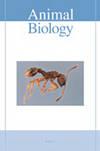时钟基因在两种鼠肾脏中的表达模式
IF 0.9
4区 生物学
Q2 ZOOLOGY
引用次数: 0
摘要
先前的研究表明,肾脏有自己的分子昼夜节律时钟表达调节,可以维持生理过程的稳态。然而,关于地下啮齿动物肾脏昼夜节律的分子机制的信息有限。在此,我们报道了分别在12L:12D(LD)或黑暗(DD)条件下饲养的地下华田鼠和相关地上勃兰特田鼠肾脏中的昼夜节律基因表达。结果表明,在LD条件下,节律基因在Brandt田鼠中的表达数量高于DD条件下,但在两种处理条件下,中国田鼠的节律基因数量相似。不同时间点的基因表达水平在DD条件下均显示出与Brandt’s田鼠LD周期中的结果相比有所降低,而在某些Zeitgeber时间点的测试基因表达水平显示出高于普通话田鼠LD周期的结果。在DD条件下,两种田鼠的基因表达峰值都显示出混乱的重置。因此,我们认为,作为对不同生活环境的适应,Mandarin和Brandt田鼠在肾脏中具有不同的分子昼夜节律时钟表达调节模式。中国田鼠似乎更适应黑暗的环境,而勃兰特田鼠更依赖外部的光照条件。本文章由计算机程序翻译,如有差异,请以英文原文为准。
Expression patterns of clock genes in the kidney of two Lasiopodomys species
Previous studies showed that the kidney has its own molecular circadian clock expression regulation that maintains the homeostasis of physiological processes. However, limited information is available on the molecular mechanisms of the kidney circadian rhythm in subterranean rodents. Here, we report circadian gene expression in the kidney of subterranean Mandarin voles and the related aboveground Brandt’s voles, reared under 12L:12D (LD) or dark (DD) conditions, respectively. The results showed that the rhythmic genes were represented in Brandt’s voles in higher numbers under LD than DD conditions, but the number of rhythmic genes in Mandarin voles was similar between the two treatment conditions. The gene expression levels at different timepoints all showed reduced results under DD conditions compared with those in the LD cycle in Brandt’s voles, whereas the expression levels of the tested genes at certain Zeitgeber timepoints showed higher results than in the LD cycle in Mandarin voles. The gene expression peak showed chaotic resetting under DD conditions in both voles. We thus suggest that Mandarin and Brandt’s voles have different molecular circadian clock expression adjustment patterns in the kidney as an adaptation to different living environments. Mandarin voles seem to be more adapted to the dark environment, while Brandt’s voles are more dependent on external light conditions.
求助全文
通过发布文献求助,成功后即可免费获取论文全文。
去求助
来源期刊

Animal Biology
生物-动物学
CiteScore
2.10
自引率
0.00%
发文量
34
审稿时长
3 months
期刊介绍:
Animal Biology publishes high quality papers and focuses on integration of the various disciplines within the broad field of zoology. These disciplines include behaviour, developmental biology, ecology, endocrinology, evolutionary biology, genomics, morphology, neurobiology, physiology, systematics and theoretical biology. Purely descriptive papers will not be considered for publication.
Animal Biology is the official journal of the Royal Dutch Zoological Society since its foundation in 1872. The journal was initially called Archives Néerlandaises de Zoologie, which was changed in 1952 to Netherlands Journal of Zoology, the current name was established in 2003.
 求助内容:
求助内容: 应助结果提醒方式:
应助结果提醒方式:


